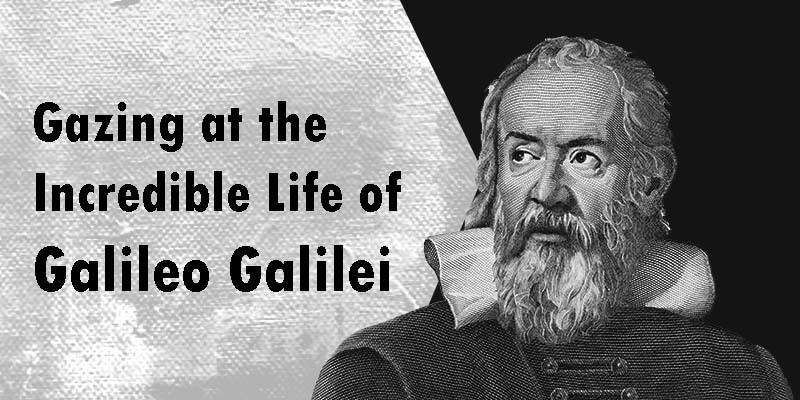
Not every astronomer can claim to have enjoyed the attention of both the Roman Inquisition and the Queen, but Galileo di Vincenzo Bonaiuti de’ Galilei (in short Galileo Galilei) was no ordinary genius.
Born on 15 February 1564, Galileo lived to the age of 77, a life span that saw the beginning of the scientific revolution in Europe. Discoverer of satellites of Jupiter, father of modern Science and also a celebrated loser of history’s most famous heresy trial, Galileo’s life has been full of notable events.
On his 458th birth anniversary, it’s worth taking a telescopic look at his remarkable scientific contributions that shook the world.
Galileo didn’t invent the telescope, but he definitely made several improvements and was the first one to aim at the sky. He could do that because, through trial and error, he eventually created a telescope in 1609 that could magnify up to 30x.

Galileo made his first telescope in 1609 that could magnify objects three times. With this telescope, he was able to look at the moon, discover the four satellites of Jupiter, observe a supernova, verify the phases of Venus, and discover sunspots.
With his telescope, he started observing many celestial bodies, including the Moon. Until this point, Aristotle’s view that the Moon was perfectly smooth was accepted as the truth. But Galileo’s telescope showed the craters on the Moon that we are all familiar with today. He also created topographical charts estimating the heights of the Moon’s mountains, thus proving Aristotle’s observations untrue.
After his landmark observation about the moon, Galileo used his telescope to make many other discoveries. He observed and saw sunspots and many new stars around Saturn and Neptune that one couldn’t see with the naked eyes. One of his biggest discoveries occurred in 1610 when he saw what he described as “three fixed stars, totally invisible by their smallness”, next to Jupiter. As he continued to observe them in the following days, he saw a fourth object that disappeared after a while. He concluded that all these objects were not fixed but orbiting the planet. What he discovered were Jupiter’s four largest moons, now named Io, Ganymede, Europa, and Callisto or simply the Galilean moons.
Galileo wrote in 1610, “Infinite thanks to God for being so kind as to make me alone the first observer of marvels kept hidden.” His discovery obviously revolutionised astronomy and also shook Aristotelian cosmology to a great length.
One of Galileo’s most famous experiments, which he likely never really performed, was the great cannonball dropping in 1589. According to popular beliefs, Galileo dropped a cannonball and a wooden ball from the Leaning Tower of Pisa to show that their time of descent was independent of their mass.
That notion was contrary to classic Greek physics by Aristotle, which held that heavier objects fall faster. In 1971, Apollo 15 astronauts repeated the experiment on the moon by dropping a hammer and a feather to confirm Galileo’s observation.
Also Read: 6 Medical Inventions that Changed the World
Galileo was the first to develop the concept of inertia, the state where an object remains at rest or in motion until some other force acts on it. Until then, it was thought that one must exert a force in order to cause and preserve motion, as explained by Aristotle’s physics.
For Galileo, the principle of inertia was fundamental to his central scientific task. He used this law to explain why we do not sense the motion of the Earth although it is spinning on its axis and orbiting the Sun. he also proved that objects falling on the surface of the earth move together with the earth.

Albert Einstein admired Galileo’s work and called him the “father of modern science.”
While the Italian astronomer’s work has earned him a lasting legacy as one of history’s greatest thinkers, not everyone during his time admired his work, especially the Catholic Church. Science and religion were intertwined during Galileo’s days. His constant debunking of Aristotle’s theories added fuel to the fire and made him unpopular amongst his academic colleagues.
His continued observations showed that the Copernican system, where the Sun and not Earth is the centre of the universe, caused major waves. This angered the Catholic Church, which believed in the biblical passage about Earth being fixed. Eventually, his work had consequences when Father Niccolò Lorini submitted his beliefs to the Inquisition in 1615, claiming that Galileo was attempting to reinterpret the Bible. For almost two decades, the church hounded Galileo for strong suspicion of heresy. He was warned to abandon any ideas that put the Sun at the centre of the universe. Luckily for his influential friends, Galileo escaped severe punishment by the church, but he was still placed under house arrest for the rest of his life.
One of the most prolific astronomers, physicists and engineers of his time, one thing that we all can take from Galileo’s life experiences, is the curiosity to ask questions and seek answers.
Read More:
Books are Tanaya Goswami’s first love and cheesecakes come a close second. Talking about movies, music, calligraphy, politics, and Elon Musk will get you listed under the friends’ section of her diary. Ever since moving on from her job as an English lecturer, she spends her time at BYJU’S crafting stories filled with emotion and sprinkled with sarcasm. Outside of work, she’s either learning something new (French, most recently!) or is curled up with a book and a cup of coffee. She firmly believes that discovering what you don’t know is the key to knowledge and is constantly working towards improving herself. Drop in a line at storyweavers@byjus.com if you liked her stories, have something nice to say, or if you have compelling ideas to share!